Conservation Status
provided by University of Alberta Museums
No specific information could be found. It can be assumed that as parasitoids, the success of the species is dependent on the success of the host or hosts.
- license
- cc-by-nc
- copyright
- University of Alberta Museums
Cyclicity
provided by University of Alberta Museums
Adults have been collected in early-to-mid May.
- license
- cc-by-nc
- copyright
- University of Alberta Museums
Distribution
provided by University of Alberta Museums
Nearctic (Hall & Evenhuis 1980).
- license
- cc-by-nc
- copyright
- University of Alberta Museums
General Description
provided by University of Alberta Museums
"4-6 mm long, 12-14 mm wingspan. Wings have brown tint and faint darker mottling throughout. Hair with blonde tint.
Characteristics shared with other Bombylius species include a slender first antennal segment, long scattered bristly hairs, holoptic males, conspicuously bristled hind femora, and a distinct intercalary vein (Hull 1973)."
- license
- cc-by-nc
- copyright
- University of Alberta Museums
Habitat
provided by University of Alberta Museums
Arid regions with loose soil of the type frequented by ground-nesting bees.
- license
- cc-by-nc
- copyright
- University of Alberta Museums
Life Cycle
provided by University of Alberta Museums
Very little species-specific information available. The general bombyliid life cycle is described in Marshall (2006). Females coat eggs with a sticky substance in order to gather a protective layer of soil when they are dropped into burrows of potential hosts. First instar larvae actively penetrate host nests, then molt into sedentary ectoparasitoids, a phenomenon known as hypermetamorphosis. Pupae are equipped with rigid ornamentation to assist escape from the burrow. Adults resemble bees as a deterrent against predators, and imitate them behaviourally and functionally by feeding on nectar and spreading pollen.
- license
- cc-by-nc
- copyright
- University of Alberta Museums
Trophic Strategy
provided by University of Alberta Museums
Larvae parasitoids of ground-nesting bees, adults feed on nectar (Hull 1973).
- license
- cc-by-nc
- copyright
- University of Alberta Museums

